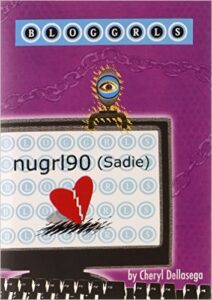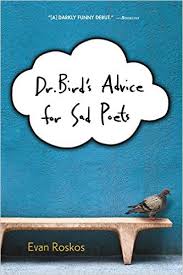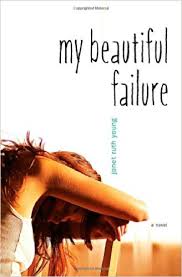#MHYALit Reading Lists: Depression, a guest post by Natalie Korsavidis
 As part of our 2016 Mental Health in Young Adult Literature project, we will be posting reading lists on various mental health-related subjects. Guest blogger Natalie Korsavidis pulled together this one on depression (and previously this one on schizophrenia). We will mainly be focusing on books published after 2000. We encourage you to add any other titles you can think of in the comments. Interested in generating a list for us? Let us know! I’m @CiteSomething on Twitter.
As part of our 2016 Mental Health in Young Adult Literature project, we will be posting reading lists on various mental health-related subjects. Guest blogger Natalie Korsavidis pulled together this one on depression (and previously this one on schizophrenia). We will mainly be focusing on books published after 2000. We encourage you to add any other titles you can think of in the comments. Interested in generating a list for us? Let us know! I’m @CiteSomething on Twitter.
Depression in YA
Annotations for the novels were found on the Farmingdale Library catalog or NoveList
 Adoff, Jamie. The Death of Jayson Porter. Hyperion Books for Children, 2008.
Adoff, Jamie. The Death of Jayson Porter. Hyperion Books for Children, 2008.
In the Florida projects, sixteen-year-old Jayson struggles with the harsh realities of his life which include an abusive mother, a drug-addicted father, and not fitting in at his predominately white school, and bring him to the brink of suicide.
ADVERTISEMENT
ADVERTISEMENT
 Borris, Albert. Crash into Me. Simon Pulse, 2010.
Borris, Albert. Crash into Me. Simon Pulse, 2010.
Four suicidal teenagers go on a “celebrity suicide road trip,” visiting the graves of famous people who have killed themselves, with the intention of ending their lives in Death Valley, California.
 Cannon, A.E. Amazing Gracie. Delacorte Press, 1991.
Cannon, A.E. Amazing Gracie. Delacorte Press, 1991.
A high school girl has a lot to deal with in her sophomore year when her beloved mother who is a victim of depression remarries, a new brother is acquired, and the family moves to Salt Lake City.
 Carlson, Melody. A Not-So-Simple Life. Multnomah Books, 2008.
Carlson, Melody. A Not-So-Simple Life. Multnomah Books, 2008.
Maya keeps a journal the year following her aunt’s death, in which she records her thoughts about her alcoholic and drug-addicted mother and her own feelings of depression, until she decides to give her heart to God.
 Carter, Alden R. Walkaway. Holiday House, 2008.
Carter, Alden R. Walkaway. Holiday House, 2008.
Fifteen-year-old Andy, fed up with his alcoholic father and annoying older brother, leaves their northern Wisconsin cabin on his version of a walkabout, leaving his medications to combat depression, anxiety, and delusions behind.
 Cook, Trish and Halpin, Brendan. A Really Awesome Mess. Egmont, 2013.
Cook, Trish and Halpin, Brendan. A Really Awesome Mess. Egmont, 2013.
An angry girl and a depressed boy, both sixteen, are sent to a therapeutic boarding school
 Crane, Rebekah. Aspen. In This Together Media, 2014.
Crane, Rebekah. Aspen. In This Together Media, 2014.
A teenage girl’s mistake on a Boulder, Colorado road left a popular teen soccer player dead. Now the deceased is following the driver around and only her boyfriend and her therapist understand her and can keep her from heading further into a deep depression.
 Dellasega, Cheryl. (NuGrl90) Sadie. Marshall Cavendish, 2007.
Dellasega, Cheryl. (NuGrl90) Sadie. Marshall Cavendish, 2007.
Fifteen-year-old Sadie writes on her blog about having to move to a new high school at the beginning of sophomore year due to her parents’ divorce, finding and losing a true love and a best friend, and being in therapy and taking antidepressants.
 Dreyer, Ellen. Glow Stone. Peachtree, 2006.
Dreyer, Ellen. Glow Stone. Peachtree, 2006.
Sixteen-year-old Phoebe cannot help but wonder if she will suffer chronic depression like her mother and her recently-deceased uncle, who shared her passion for rock-collecting, until the terrifying experience of being lost in a cave provides the answer.
 Ellis, Ann Dee. Everything is Fine. Little, Brown, 2009.
Ellis, Ann Dee. Everything is Fine. Little, Brown, 2009.
When her father leaves for a job out of town, Mazzy is left at home to try to cope with her mother, who has been severely depressed since the death of Mazzy’s baby sister.
 Frank, E.R. America. Atheneum Books for Young Readers, 2002.
Frank, E.R. America. Atheneum Books for Young Readers, 2002.
Born to a drug-addicted mother, 15-year-old America had been lost in the child-welfare system for years before he finally wound up in a residential treatment center. There, over a period of several more years, a capable therapist coaxes him out of his anger and suicidal depression.
 Franklin, Kristine. Eclipse. Candlewick Press, 1995.
Franklin, Kristine. Eclipse. Candlewick Press, 1995.
When Trina’s father falls into a severe depression after losing his job and her mother becomes pregnant at forty-eight, Trina faces a difficult summer even with the help of her good friend Miranda.
 Fritz, April Young. Waiting to Disappear. Hyperion Books, 2002.
Fritz, April Young. Waiting to Disappear. Hyperion Books, 2002.
After the death of her brother two years ago, Buddy’s mother hasn’t been the same, and when her depression leads to a mental breakdown, Buddy’s hopes of a relatively peaceful summer are dashed.
 Going, K.L. Fat Kid Rules the World. Speak, 2003.
Going, K.L. Fat Kid Rules the World. Speak, 2003.
Seventeen-year-old Troy, depressed, suicidal, and weighing nearly 300 pounds, gets a new perspective on life when a homeless teenager who is a genius on guitar wants Troy to be the drummer in his rock band.
 Halpern, Julie. Get Well Soon. Feiwel and Friends, 2007.
Halpern, Julie. Get Well Soon. Feiwel and Friends, 2007.
When her parents confine her to a mental hospital, an overweight teenage girl, who suffers from panic attacks, describes her experiences in a series of letters to a friend.
 Hiranandani, Veera. The Whole Story of Half a Girl. Delacorte Press, 2012.
Hiranandani, Veera. The Whole Story of Half a Girl. Delacorte Press, 2012.
When Sonia’s father loses his job and she must move from her small, supportive private school to a public middle school, the half-Jewish half-Indian sixth-grader experiences culture shock as she tries to navigate the school’s unfamiliar social scene, and after her father is diagnosed with clinical depression, she finds herself becoming even more confused about herself and her family.
 Holeman, Linda. Mercy’s Birds. Tundra Books, 1998.
Holeman, Linda. Mercy’s Birds. Tundra Books, 1998.
As her mother sinks into depression and her aunt turns to alcohol, fifteen-year-old Mercy tries to keep up with school and her job, until help comes for them from an unexpected source.
 Holmes, Sarah. Letters from Rapunzel. Harper Collins, 2006.
Holmes, Sarah. Letters from Rapunzel. Harper Collins, 2006.
Through a series of letters written to a post office box, twelve-year-old Cadence describes her father’s hospitalization for depression, her subsequent problems at school, and her hope that the mysterious recipient will help her find a happy ending.
 Hubbard, Jennifer R. Try Not to Breathe. Viking, 2012.
Hubbard, Jennifer R. Try Not to Breathe. Viking, 2012.
The summer Ryan is released from a mental hospital following his suicide attempt, he meets Nicki, who gets him to share his darkest secrets while hiding secrets of her own.
 Hurwitz, Laura. Disappear Home. Albert Whitman and Company, 2015.
Hurwitz, Laura. Disappear Home. Albert Whitman and Company, 2015.
In 1970, fourteen-year-old Shoshanna, six-year-old Mara, and their mother escape from Sweet Earth Farm, a declining commune run by their tyrranical and abusive father, but after finding peace and stability at Avery Elliot’s farm, their mother’s crippling depression returns.
 Jenkins, Amanda. Damage. HarperCollins, 2001.
Jenkins, Amanda. Damage. HarperCollins, 2001.
Seventeen-year-old football hero Austin, trying to understand the inexplicable depression that has drained his interest in life, thinks that he has found relief in a girl who seems very special.
 LaCour, Nina. Hold Still. Dutton, 2009.
LaCour, Nina. Hold Still. Dutton, 2009.
Ingrid didn’t leave a note. Three months after her best friend’s suicide, Caitlin finds what she left instead: a journal, hidden under Caitlin’s bed.
 Littman, Sarah. Backlash. Scholastic, 2015.
Littman, Sarah. Backlash. Scholastic, 2015.
For sophomore Lara Kelly, things are finally looking up—she’s feeling more confident after losing weight and she made the varsity cheerleading team, which she never would have imagined two years earlier when she was overweight and severely depressed. Best of all, Lara has caught the attention of a cute guy on Facebook, and he has been hinting at asking her to the homecoming dance. But when she sees horrible comments from her crush on social media, she spirals into a dangerous mental state and suicide seems like the only escape.
 Loughead, Deb. Beyond Crazy. James Lorimer and Company, 2014.
Loughead, Deb. Beyond Crazy. James Lorimer and Company, 2014.
For Stelle, being drummer in a band is what helps her cope with her mother’s depression and the problems her bandmates face with their families, until some conversations with her grandmother provide clues to the source of her mother’s condition.
 Marchetta, Melina. Saving Francesca. Alfred A. Knopf, 2006.
Marchetta, Melina. Saving Francesca. Alfred A. Knopf, 2006.
Sixteen-year-old Francesca could use her outspoken mother’s help with the problems of being one of a handful of girls at a parochial school that has just turned co-ed, but her mother has suddenly become severely depressed.
 Newbery, Linda. Flightsend. Random House Children’s Books, 2010.
Newbery, Linda. Flightsend. Random House Children’s Books, 2010.
When Charlie’s depressed mother decides to start over, they move to a ramshackle cottage in the country, where Charlie struggles to make friends and develop her artistic skills while her mother tries to launch a business.
 Niven, Jennifer. All the Bright Places. Alfred A. Knopf, 2015.
Niven, Jennifer. All the Bright Places. Alfred A. Knopf, 2015.
Told in alternating voices, when Theodore Finch and Violet Markey meet on the ledge of the bell tower at school–both teetering on the edge–it’s the beginning of an unlikely relationship, a journey to discover the “natural wonders” of the state of Indiana, and two teens’ desperate desire to heal and save one another.
 Oseman, Alice. Solitaire. HarperTeen, 2015.
Oseman, Alice. Solitaire. HarperTeen, 2015.
Tori Spring is a disaffected teenager: She can almost never finish a film in one sitting, she’s smart but can’t care about school anymore, and she dislikes her friends but is unwilling to forgo their company. About the only thing she cares about is her brother Charlie, who’s recovering from an eating disorder. When a mysterious blog called Solitaire starts triggering pranks at her school, Tori isn’t too interested, even if strange new boy Michael Holden tries to make her be.
 Peters, Julie Ann. Define Normal. Little, Brown, 2000.
Peters, Julie Ann. Define Normal. Little, Brown, 2000.
When Antonia is assigned to Jazz as a peer counselor, she figures there is no way she can help her. They are complete opposites. Antonia is a straight-A student whose parents are divorced and she is struggling to keep what’s left of her family together as her mother battles depression. Jazz’s family is wealthy and seemingly perfect. As they continue through the 15 hours of peer counseling, it becomes clear that both girls have issues they need to work through
 Quick, Matthew. Sorta Like a Rock Star. Little, Brown, 2010.
Quick, Matthew. Sorta Like a Rock Star. Little, Brown, 2010.
Although seventeen-year-old Amber Appleton is homeless, she is a relentless optimist who visits the elderly at a nursing home, teaches English to Korean Catholic women with the use of rhythm and blues music, and befriends a solitary Vietnam veteran and his dog, but eventually she experiences one burden more than she can bear and slips into a deep depression.
 Rodriguez, Cindy L. When Reason Breaks. Bloomsbury, 2015.
Rodriguez, Cindy L. When Reason Breaks. Bloomsbury, 2015.
A Goth girl with an attitude problem, Elizabeth Davis must learn to control her anger before it destroys her. Emily Delgado appears to be a smart, sweet girl, with a normal life, but as depression clutches at her, she struggles to feel normal. Both girls are in Ms. Diaz’s English class, where they connect to the words of Emily Dickinson
 Roskos, Evan. Dr. Bird’s Advice for Sad Poets. Houghton Mifflin, 2013.
Roskos, Evan. Dr. Bird’s Advice for Sad Poets. Houghton Mifflin, 2013.
A sixteen-year-old boy wrestling with depression and anxiety tries to cope by writing poems, reciting Walt Whitman, hugging trees, and figuring out why his sister has been kicked out of the house.
 Sappenfield, Heather. The View From Who I Was. Flux, 2015.
Sappenfield, Heather. The View From Who I Was. Flux, 2015.
As part of herself observes, eighteen-year-old Oona Antunes attempts suicide, tries to pull her family and her life back together, and begins to understand her own problems and those of her parents before finally becoming one with herself again.
 Stella, Leslie. Permanent Record. Amazon Children’s, 2013.
Stella, Leslie. Permanent Record. Amazon Children’s, 2013.
Having left public school under mysterious circumstances, sixteen-year-old junior Badi Hessamizadeh enters Magnificat Academy, where he struggles with his Iranian-American identity, his clinical depression, and bullies.
 Stork, Francisco X. The Memory of Light. Arthur A. Levine Books, 2016.
Stork, Francisco X. The Memory of Light. Arthur A. Levine Books, 2016.
Waking up in the mental disorders ward after a suicide attempt, Vicky makes friends with other at-risk kids, who under the guidance of a compassionate doctor help her through the first steps towards self-acceptance and confronting the challenges that prompted her depression.
 Vizzini, Ned. It’s Kind of a Funny Story. Miramax Books, 2006.
Vizzini, Ned. It’s Kind of a Funny Story. Miramax Books, 2006.
A humorous account of a New York City teenager’s battle with depression and his time spent in a psychiatric hospital.
 Waite, Judy. Shopaholic. Atheneum Books for Young Readers, 2003.
Waite, Judy. Shopaholic. Atheneum Books for Young Readers, 2003.
Tired of household responsibilities and her mother’s depression, Taylor allows a new friend to persuade her to buy things she can’t afford, but soon discovers that Kat has even more secrets than she has.
 Walton, K.M. Empty. Simon Pulse, 2013.
Walton, K.M. Empty. Simon Pulse, 2013.
Deeply depressed after her father cheated on and divorced her mother, seventeen-year-old Adele has gained over seventy pounds and is being bullied and abused at school–to the point of being raped and accused of being the aggressor.
 Warga, Jasmine. My Heart and Other Black Holes. Balzar + Bray, 2015.
Warga, Jasmine. My Heart and Other Black Holes. Balzar + Bray, 2015.
Seventeen-year-old Aysel’s hobby–planning her own death–take a new path when she meets a boy who has similar plan of his own.
 White,Tracy. How I Made it to Eighteen: A Mostly True Story. Roaring Brook Press, 2010.
White,Tracy. How I Made it to Eighteen: A Mostly True Story. Roaring Brook Press, 2010.
How do you know if you’re on the verge of a nervous breakdown? For seventeen-year-old Stacy Black, it all begins with the smashing of a window. After putting her fist through the glass, she checks into a mental hospital. Stacy hates it there but despite herself slowly realizes she has to face the reasons for her depression to stop from self-destructing.
 Wittlinger, Ellen. Blind Faith. Simon & Schuster Books for Young Readers, 2006.
Wittlinger, Ellen. Blind Faith. Simon & Schuster Books for Young Readers, 2006.
While coping with her grandmother’s sudden death and her mother’s resulting depression and fascination with a spiritualist church, whose ministers claim to communicate with the dead, fifteen-year-old Liz finds herself falling for a new neighbor whose mother is dying of cancer.
 Young, Janet. The Opposite of Music. Atheneum Books for Young Readers, 2007.
Young, Janet. The Opposite of Music. Atheneum Books for Young Readers, 2007.
With his family, fifteen-year-old Billy struggles to help his father deal with a debilitating depression.
 Young, Janet. My Beautiful Failure. Atheneum Books for Young Readers, 2012.
Young, Janet. My Beautiful Failure. Atheneum Books for Young Readers, 2012.
Billy’s family is still recovering from last winter, when the teen’s father sank into a deep depression that he’s only now just coming out of. Billy, 16, channels his frustrations and worry about his father’s mental health into his sophomore-year project, volunteering as a friendly, welcoming ear for the depressed, lonely, and/or bored callers to the Listeners hotline.
 Young, Suzanne. The Program. Simon Pulse, 2013.
Young, Suzanne. The Program. Simon Pulse, 2013.
When suicide becomes a worldwide epidemic, the only known cure is The Program, a treatment in which painful memories are erased, a fate worse than death to seventeen-year-old Sloane who knows that The Program will steal memories of her dead brother and boyfriend.
Meet Natalie Korsavidis
 Natalie Korsavidis is the Head of Young Adult at the Farmingdale Public Library. She received her MLS at CW Post University. She is currently President of the Young Adult Services Division of the Nassau County Library Association. She has spoken at New York Comic Con and the Long Island Pop Culture Convention.
Natalie Korsavidis is the Head of Young Adult at the Farmingdale Public Library. She received her MLS at CW Post University. She is currently President of the Young Adult Services Division of the Nassau County Library Association. She has spoken at New York Comic Con and the Long Island Pop Culture Convention.
SEE ALL OF THE #MHYALIT POSTS HERE
Filed under: Uncategorized
About Amanda MacGregor
Amanda MacGregor works in an elementary library, loves dogs, and can be found on Twitter @CiteSomething.
ADVERTISEMENT
ADVERTISEMENT
SLJ Blog Network
Name That LEGO Book Cover! (#53)
Cover Reveal and Q&A: The One and Only Googoosh with Azadeh Westergaard
Exclusive: Vol. 2 of The Weirn Books Is Coming in October | News
Fighting Public School Book Bans with the Civil Rights Act
ADVERTISEMENT








Natalie,
I’m so glad to see THE VIEW FROM WHO I WAS on this fine list!
Thanks,
Heather Sappenfield